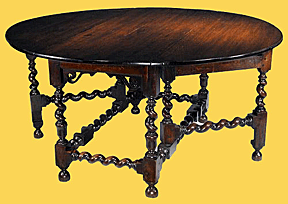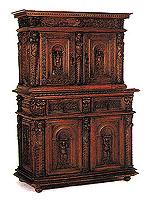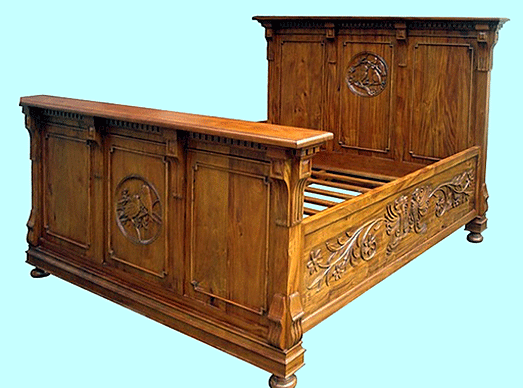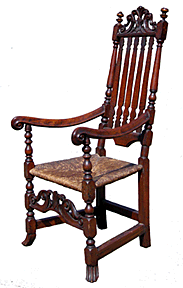The Beginnings of American
Furniture
by
Bob Brooke
 American
furniture, just like Americans, is a mix of different styles resulting
from the blending of styles of furniture brought to America by its
immigrants. When the Pilgrims landed at Plymouth Rock in 1620, they
brought with them a few meager possessions– an armchair, a small table,
a desk. Cabinetmakers of the time constructed these pieces in what’s
known as the Jacobean style. American
furniture, just like Americans, is a mix of different styles resulting
from the blending of styles of furniture brought to America by its
immigrants. When the Pilgrims landed at Plymouth Rock in 1620, they
brought with them a few meager possessions– an armchair, a small table,
a desk. Cabinetmakers of the time constructed these pieces in what’s
known as the Jacobean style.
Jacobean and William and Mary furniture tended to be heavy, almost
ponderous. Craftsmen made in both England and America of solid wood,
especially oak, although walnut became quite fashionable for William and
Mary pieces. Simplicity of structure, straight lines, and squat
proportions were typical. Legs were firmly braced with stretchers
 Cabinetmakers
preferred carving to inlay and veneer for decoration. Many a Jacobean
piece appeared weighted down by its carving. Wood panels were common on
the doors of chests, carved in geometric designs. A variation was
strapwork consisting of thin, flat pieces of wood. They also constructed
the backs of chairs of solid wood, often carved. Although they
upholstered seats with leather or woven pads in England, those in
America mostly used rush. Cabinetmakers
preferred carving to inlay and veneer for decoration. Many a Jacobean
piece appeared weighted down by its carving. Wood panels were common on
the doors of chests, carved in geometric designs. A variation was
strapwork consisting of thin, flat pieces of wood. They also constructed
the backs of chairs of solid wood, often carved. Although they
upholstered seats with leather or woven pads in England, those in
America mostly used rush.
Beds were monstrous, although how much of this effect was due to the
bedstead and how much to the hangings is a question. Never before or
since have beds been so high as between 1600 and 1660. Hangings, used to
keep out the cold night air, could be drawn to cover the four sides of a
bed. Children and servants slept in trundle beds, which were low and on
wheels so they could be pushed under a bedstead. Daybeds, the
forerunners of reclining couches, were quite common.

Tables were long. The trestle, which is the oldest style
of table and goes back to Medieval times, began to have some
competition. Cabinetmakers began making gateleg tables, a style still
popular today, first during the Jacobean period. Cricket tables with
three legs were also new.
Stools, about the height of a chair seat and made in large numbers, were
even more common than chairs. They often doubled as tables.
 Side
chairs and armchairs, which were really side chairs with wood arms
attached, offered little choice when it came to comfort. In addition to
solidbacks, there were slat-back chairs, which had three or more wide
and usually shaped wooden pieces horizontally across the back. The
banister-back chair had fairly wide vertical slats surmounted by a crest
or top rail. Cabinetmakers carved some of these top rails, as well as
the banisters, more richly carved than others. Side
chairs and armchairs, which were really side chairs with wood arms
attached, offered little choice when it came to comfort. In addition to
solidbacks, there were slat-back chairs, which had three or more wide
and usually shaped wooden pieces horizontally across the back. The
banister-back chair had fairly wide vertical slats surmounted by a crest
or top rail. Cabinetmakers carved some of these top rails, as well as
the banisters, more richly carved than others.
The latter part of the 17th century, technically known as the
Restoration Period in England, followed by William and Mary, brought
with it lighter and more adaptable furniture. Special turnings, scrolled
and more elaborate stretchers, became fashionable. Decorations expanded
to include lacquer, marquetry, and some inlay. To read
more of my articles, please
visit
my Web site.
<
Back to Antiques Articles
Next Article >
|
